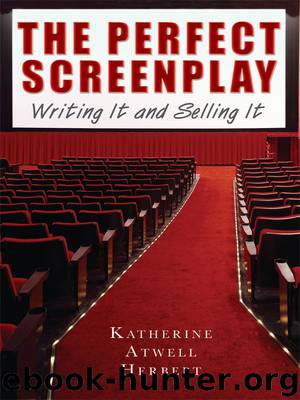The Perfect Screenplay by Katherine Herbert

Author:Katherine Herbert
Format: epub
ISBN: 9781581158465
Publisher: Allworth Press / Skyhorse Publishing, Inc. (Perseus)
4. Dueling Dialogue: When two characters speak at the same time, their dialogue can be put on the page side by side; or, in the description, indicate that both characters speak at the same time, then place the chunks of dialogue one after the other.
5. FADE IN/FADE OUT: FADE IN is only used at the beginning of the script. FADE OUT is generally used only at the end. It is sufficient, but if you want to add or substitute THE END, you can do that.
6. Flashbacks and Dream (or Fantasy) Sequences: To indicate a dream or flashback sequence, treat them as scene headings by writing: BEGIN FLASHBACK or BEGIN DREAM SEQUENCE. Don’t forget to end the sequence by writing: END FLASHBACK or END DREAM SEQUENCE or END FANTASY SEQUENCE.
7. Montage: A montage is indicated in the same manner as flashbacks. The shots to be included in the montage are usually listed with brief descriptions.
8. Parenthetical: This is material placed in parentheses immediately under a character’s name, or in mid-dialogue if appropriate. It indicates how the line should be read.
9. Phone Calls: When two people are speaking together on the phone, it can be indicated either by cross-cutting between the two characters, or by having one character who is heard but not seen on screen. Generally, you follow the off-screen character’s name with (ON THE PHONE) or (ON PHONE).
Example:
HARRY (ON PHONE)
So, what do you say, Harriet?
10. Scene Description: This follows the scene heading and very briefly describes the scene and action.
11. Scene Heading/Slug Line/Scene Slug: This is the basic information at the beginning of each scene. It indicates if the scene is interior (INT.) or exterior (EXT.), where the scene is taking place, and what time of day it is.
12. Sotto Voce and Ad Lib: Sotto Voce means “under the breath.” When you want a character to say something other characters can’t hear, use (SOTTO VOCE) as a parenthetical. Use (AD LIB) to indicate when you want the actor(s) to create their own lines. Often used for background characters’ scenes or when characters greet each other. Don’t use it very often.
13. Times of Day: You don’t have to specify anything more than DAY or NIGHT in your scene heading. If you want something more specific because it’s important to your story, you can include it. Don’t do it too often or be too specific unless it’s crucial. If one scene immediately follows the previous one, you write: CONTINUOUS, FOLLOWING, or IMMEDIATELY AFTER. If a scene is happening in another place at exactly the same time as the previous scene, write AT THE SAME TIME or SIMULTANEOUSLY.
14. Transitions: This material indicates how the writer wants to move (cut, fade, dissolve, etc.) from one scene to another.
15. V.O. and O.S. When a character isn’t on screen but is part of the scene you’re writing, following the character’s name above the dialogue, write (O.S.). When a character isn’t really part of the scene but is “watching” or narrating it, following the character’s name above the dialogue, write (V.
Download
This site does not store any files on its server. We only index and link to content provided by other sites. Please contact the content providers to delete copyright contents if any and email us, we'll remove relevant links or contents immediately.
Asking the Right Questions: A Guide to Critical Thinking by M. Neil Browne & Stuart M. Keeley(5705)
Autoboyography by Christina Lauren(5203)
Eat That Frog! by Brian Tracy(4479)
Dialogue by Robert McKee(4353)
Sticky Fingers by Joe Hagan(4142)
Journeys Out of the Body by Robert Monroe(3588)
Annapurna by Maurice Herzog(3446)
Full Circle by Michael Palin(3414)
Schaum's Quick Guide to Writing Great Short Stories by Margaret Lucke(3342)
Elements of Style 2017 by Richard De A'Morelli(3323)
The Art of Dramatic Writing: Its Basis in the Creative Interpretation of Human Motives by Egri Lajos(3036)
Atlas Obscura by Joshua Foer(2931)
Why I Write by George Orwell(2911)
The Diviners by Libba Bray(2906)
In Patagonia by Bruce Chatwin(2894)
The Fight by Norman Mailer(2885)
The Mental Game of Writing: How to Overcome Obstacles, Stay Creative and Productive, and Free Your Mind for Success by James Scott Bell(2873)
Venice by Jan Morris(2546)
The Elements of Style by William Strunk and E. B. White(2452)
